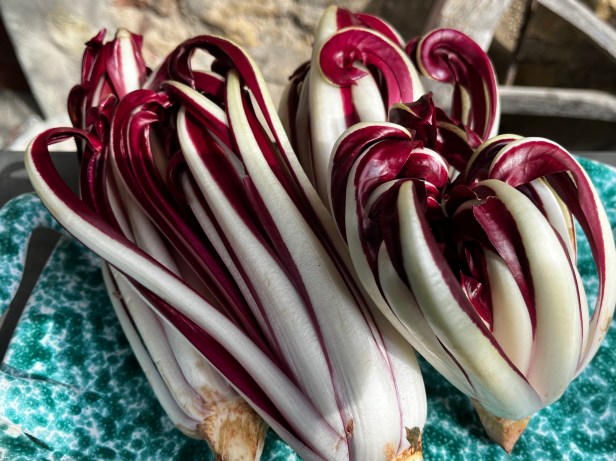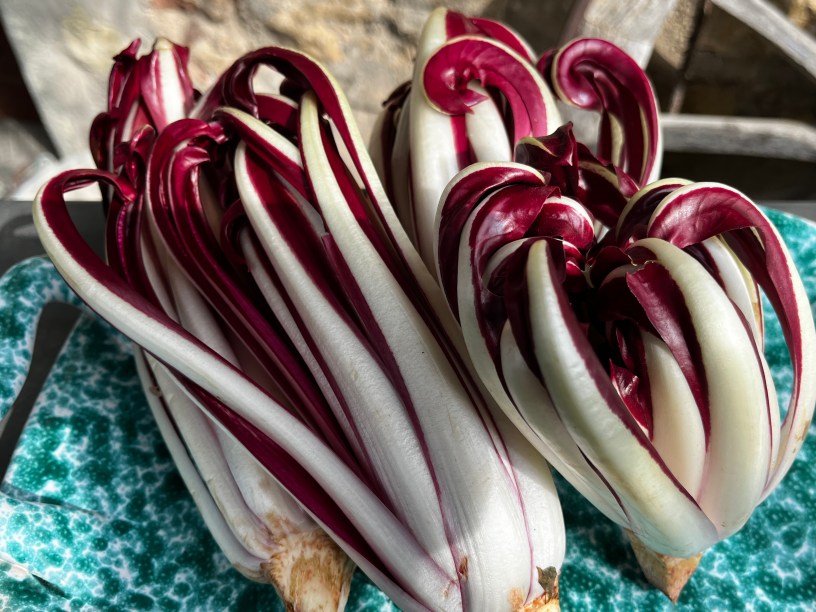
Radicchio is a vegetable we eat many times at home as it’s easy to be served raw or cooked and it’s available from October to March. Not everybody in the family is so happy with it because of its “amarognolo” taste, i.e. spicy bitter.
One radicchio that makes everybody happy is the Treviso red radicchio tardive/late growing.
Let’s explain the Treviso radicchio may be early -growing and late – growing

At the botanical level they are both considered Cichories but at the sight they are two different plants, although both grow in a tuft and have purple leaves with evident white veins.
The early Treviso Radicchio looks like a long head composed of wide and elongated leaves. And although it is less considered than the late, it must absolutely be remembered that the early Treviso radicchio is the progenitor of all colored leafy chicory: it is from it, in fact, that the radicchio that we can taste today have been selected.
The late growing Treviso Radicchio is a not entirely compact head that many call Spadone for the shape of its leaves: narrow and long that end with a sort of tip like a broadsword.
Late-growing Treviso radicchio is a highly valued and expensive product but when you realise the amount of work that goes into its production, you will understand why.

To be the authentic Red Radicchio of Treviso PGI (Place of origin and Processing)must come from the typical area located between the provinces of Treviso, Padua and Venice and must be obtained according to the traditional technique of forcing and bleaching during which the bouquets, after harvesting – which takes place from October 20th – are placed in tanks filled with running spring water.After about fifteen days, that is, once the new sprouts have been obtained, they proceed with the grooming, washing and packaging phase. Once ready, the appearance shows in the typical lanceolate shape, with regular and compact shoots that tend to close at the apex.
The leaf flap is intense red with a white main rib. Its unmistakable shape makes it extremely regal in appearance.
If you want to see his growth, watch the video prepared by the Consorzio Tutela Radicchio Rosso di Treviso e Variegato di Castelfranco(Protection Consortium).Gorgeous images.
Don’t forget that purple and blue produce like red cabbage and blueberries are filled with anthocyanins, which give those foods their vibrant color and can have anti-inflammatory, anti-cancer, anti-obesity, and anti-diabetic effects, as well as promoting brain health and helping to prevent heart disease.
What does radicchio taste like?
When eaten raw, its white veined, purple leaves have a delightfully sharp and bitter flavor.

Hot to prepare it?
Raw:Slice it lengthwise,then in smaller pieces and dress it with salt .Serve it with fresh and mature cheeses, accompanied with a drizzle of honey and a few walnuts.
Cooked:it’s also pretty common to cook radicchio , either by boiling, sautéing, roasting, or grilling. The cooking brings out some natural sweetness while still providing that iconic bitter kick.

Cooked:Cut it lengthwise,pour a tbsp. EVOO in a pan and cook the radicchio in the pan for 5 minutes.Serve it dressed with oil, salt and pepper.Simple but tasty !
According to the people of Treviso, the best way to enjoy it is in a delicious risotto creamed with a medium mature Asiago cheese
Whatever way you cook radicchio, it’s a delicious, healthy way to spice up your dish.
If you don’t find it at home, don’t forget to taste it when in Italy.
